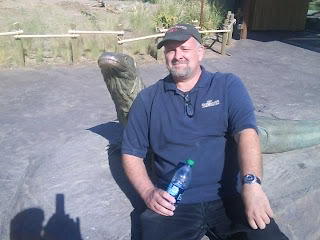The book, which heartbreakingly explores the plight of animals by relating it to human evil—to the Holocaust, not to put too fine a point on it—filled me with the desire to get a clear physical sense of the animals it so endearingly describes.
As it happens, the Phoenix Zoo is close enough to The Day Gig that in the morning I can often hear the hootings & crowings of creatures from around the globe. I had been wanting, anyway, to see the new additions to the collection, male & female komodo dragons. So I asked, at the front gate, if they had a list available of all the animals in the collection.
To my astonishment, the lady told me that I was the first person who had ever asked her for this. She then referred me to the nearby ranger station. The ranger there informed me that the Zoo did, indeed, have howler monkeys, displayed on the “Forest of Uco” trail, which features South American fauna. She wasn’t sure about the donkey, but she checked, & sure enough, they had one donkey as well, named Pedro, in the children’s zoo.
It was a hot weekday afternoon and the school year wasn’t over yet, so the Zoo was quiet. Within ten minutes, I was standing in front of the howler monkey cage. The bigger, darker-furred occupant, the male I presume, shuffled off into the shadows upon my arrival, but a smaller, caramel-colored specimen lounged in the spreading fingers of a tree branch, limbs & tail dangling, gazing at me with disinterest. A lovely little primate, but a dimly-visible silhouette behind the mesh, so I soon moved on.
A bit farther down, the path veered off over a little footbridge to the children’s zoo, which seemed to be deserted. Not only were there no children visible, there didn’t seem to be any keepers around. In a barn, however, I found a row of three stables. In the first two were horses, but over the door to the last was a sign that read PEDRO. The beast in question, grayish-brown with a pretty dark-brown cross pattern down his back & over his shoulders, was munching away from a feed trough.
I called him by name, gently, & he turned to look at me with startled dark eyes. He declined to come out & visit, though, returning to his lunch.
On my way to & from these specimens, I saw a splendid anteater cohabiting with a maned wolf, a rhinoceros iguana sunning itself, a jaguar, otters, several varieties of parrot & tortoise, & an outdoor aquarium full of South American freshwater fish including an enormous, piranha-like Pacu. I was running a bit late, but I had enough time to stop by & see the Zoo’s latest pride and joy: Komodo Dragons, enormous carrion-eating reptiles from Indonesia, the world’s largest lizards. The smaller female was demurely resting under a log in her enclosure, but the big male, alone among the animals I saw that day, was in a sociable mood, lumbering around in the sun and striking handsome poses suitable for photographing.
Even so, I left with the same ambivalence that Zoos usually give me—on the one hand, the high of the almost religious joy that I, like many people, find simply in the presence of animals. On the other, the awareness of how dangerous that feeling is for them, how much suffering & death the human fascination with animals has caused our unfortunate planet-mates, how much better served they’d be if we were just respectfully indifferent to them.
“Zoos are bastard patches of nature,” pronounces the mysterious Taxidermist in Beatrice and Virgil. “The animals there are degenerate.” Henry, Martel’s mild-mannered hero, offers a conciliatory reply: “Well, zoos are a compromise, that’s for certain, but so is nature…I see zoos as embassies from the wild, each animal representing its species…”
Both judgments are surely true in some measure. Sad to think, though, that our relations with the Animal World are such that the formality of embassies is required.





hello, i am catching up on your posts. we have a trading-card picture of a komodo dragon on our mantel (i think it came out of a cereal box or something); don calls it the "editor-biter," b/c of the one that bit the toe of sf chronicle editor phil bronstein at the l.a. zoo. (i don't think it's the same one, but who can tell?) awesome pic of you with your new pal!
ReplyDeleteMuch appreciated; always glad when you stop by. I've just done a post on "Star Trek"; would love to get your thoughts on it.
ReplyDeleteHope you're doing well. I remember hearing about poor Bronstein's misfortune; wasn't it the noir-ishly suspicious result of a birthday excursion gone bad, having been set up by Sharon Stone?